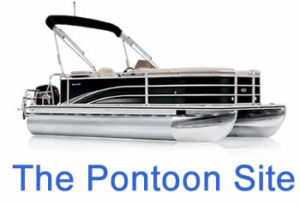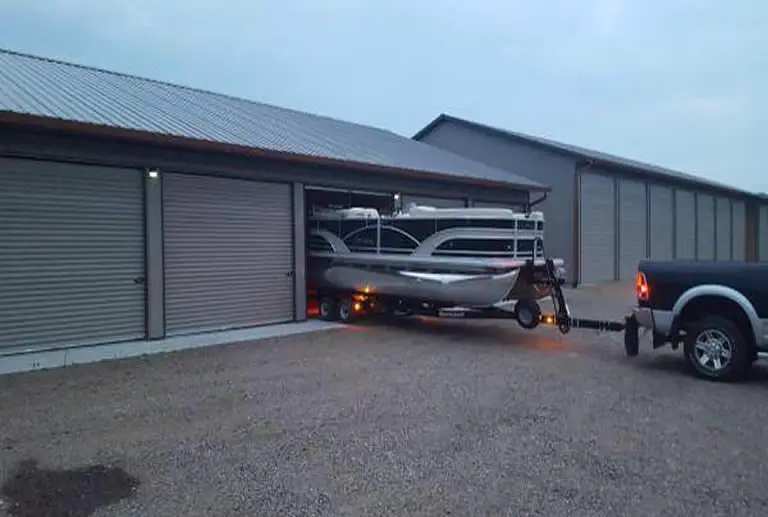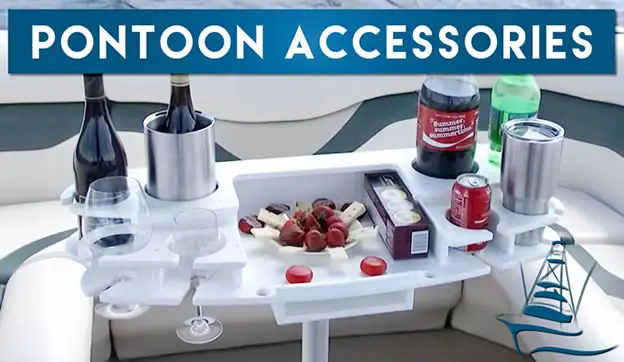Pontoon boats take very little effort to get them moving on the water but how do you get them to the water in the first place? Although the advice in this article is targeted to pontoon boat owners, the information applies to all types of boats. What size trailer do you need for a pontoon boat or other type pf boat?
An 18 foot boat requires an a 18 – 21 foot long trailer. A 21 foot boat requires a 21 – 24 foot long trailer. A 24 foot boat requires a 21 – 27 foot long trailer. Opting for the bigger sized trailer is advised as it gives you extra space when turning thus keeping the front of the boat further away from the rear of the road vehicle.
Contents
Common boat trailer sizes
The size and type of the trailer you choose for your pontoon boat will depend largely on two things:
- The size of your boat.
- The weight of your boat.
Although there are other things to consider (which I will cover later) it is these two variables that will affect your trailer choice the most.
Let’s take a look at why that is so now.
Boat size is a key consideration when selecting a trailer
The common practice for picking a pontoon boat trailer is to match the size of the trailer to the size of your boat. This makes picking a trailer really easy.
If you have a 21 foot pontoon boat then common practice dictates you get a 21 foot pontoon boat trailer. If you have a 28 foot boat you get a 28 foot trailer. Simple!
However, I strongly advise you not to follow common practice and instead follow best practice.
Best practice dictates you get a trailer with a little extra length i.e. instead of a 21 foot trailer for your 21 foot pontoon boat you should get a 24 foot trailer. This extra length gives you a little bit extra swing radius when taking corners and means the front of the trailer and boat are further away from the rear of your road vehicle.
As someone who once drove commercial buses in Ireland (it’s a long story) I know the advantage that a little bit of extra room can give you especially on tight turns. So, in my opinion I would suggest you always go for a slightly longer trailer than the length of your pontoon boat.
As a rule-of-thumb take the length of your boat and add 3 feet to that number and you ave the ideal length of trailer for your pontoon boat.
Trailer lengths for pontoon boats:
- 18 foot pontoon boat – 18 – 21 foot trailer.
- 21 foot pontoon boat – 21 – 24 foot trailer.
- 24 foot pontoon boat – 24 – 28 foot trailer.
The boat weight greatly affects the axle count you need on a trailer
The weight of your pontoon boat also has an major effect on the trailer you need.
The number of axles on the boat trailer should correctly match the weight of your pontoon boat. What do I mean by this?
Well, it is the axle count that determines how much weight the trailer can handle rather than the size of the trailer.
Here are the number of axles a trailer should have based on pontoon boat weight:
- Single axle trailer – up to 2,250 lbs. This usually equates to a 14 – 20 foot pontoon boat.
- Dual axle trailer – 2,250 lbs to 4,800 lbs. This usually equates to a 20 – 28 foot pontoon boat.
- Triple-axle trailer – 4,800 lbs to 6,000 lbs. This usually equates to a 28 – 34 foot pontoon boat.
Other trailer considerations
The size and weight of your pontoon boat are not the only things to consider when choosing a trailer.
If you want to ensure your boat is safe and secure there are other keys things you need to take into account before making a trailer purchase.
The terrain the trailer will move across matters
For the most part you will probably be towing your pontoon boat on smooth roads, but do give some consideration the terrain you have to drive through to get to your final destination.
You should always match the tires of your trailer to the type of terrain that you regularly haul your pontoon boat on.
As pontoon boat can be heavy fitting the correct tires to your road vehicle can a long way to making trailering easier. For example, radial tires will wear well and give you a smooth drive on smooth roads however, ply tires will give you better grip and less slip on rough terrain.
So if you have to cover rough ground to get to the water where you launch your boat it may be a better idea to opt for quicker wearing ply tires for the extra control they give you. The hassle and cost of replacing the tires sooner is well outweighed by the safety and operational factors they offer you.
Always go for a multi-ply tire rather than a single-ply, if you choose to use ply tires. A single ply tire has only one layer giving less support while the multi-ply tires have multiple layers thus giving extra support for heavier loads.
The trailer tire size matters too
Always go for a wide diameter tire as they are larger.
Large diameters, being bigger, cover more ground per revolution than a smaller-diameter tire leading to less strain on the wheel and less wear on the tire.
The trailer must have blinkers
A good pontoon trailer must have working blinkers by law.
This means the trailer must have at least:
- 2 reflectors.
- Working stop lights.
- Working tail lights.
- Working blinkers on each side.
- A license plate with registration clearly visible.
There are additional legal requirements that must be followed depending on the width and length of the trailer. If you buy your trailer new be sure to ask the retailer if the trailer fits the state laws in the specific states that you will be using it in.
Lastly, ensure the electrical cords on the trailer are good quality with no apparent brittleness and make sure the connectors are sturdy.
Always check your trailer lights are working correctly before moving off. It’s not only dangerous to have malfunctioning lights on a pontoon trailer (because vehicles behind you can’t see your road vehicle’s lights), but it’s also illegal and you could be fined and have your trailer, with the boat on it, impounded.
Popular types of boat trailers available
All pontoon trailers are not alike.
There are two different types of pontoon boat trailer:
- Scissor/Up down trailer.
- Bunk/float-on trailer.
What’s the difference and why does it matter? Let’s find out.
The scissor boat trailer
Scissor trailers, also known as up/down trailers, work by fitting between the tubes on the pontoon boat.
The trailer fits neatly underneath and between the 2 tubes. Obviously these trailers are not a good fit for tritoons.
The trailer is pretty hassle-free and offers the easiest way to trailer a pontoon boat, both on and off the water.
The bottom of the platform of the pontoon boat sits on the crossbeams of the trailer.
The good thing about this type of trailer is that the position of the boat does not have to be exact when you load it. Unfortunately though, this means potential stability issues when towing the boat. As the tubes sit on the outside of the trailer it makes the entire set-up a lot less stable than if the boat was fully contained on/within the trailer.
Rocking of your boat on one of these trailers is not uncommon when traveling at speed on the highway. This can feel a little unnerving when you are hauling a boat worth tens of thousands of dollars. Although the boat is stable this scenario is not ideal if you have to travel long distances as it makes for an uncomfortable ride.
Another good thing about a scissor trailer is that you can use it in very shallow water.
The scissor trailer is best for people who want to trailer quickly and with as little hassle as possible. It suits those pontoon boat owners who don’t have to travel far to launch their boats.
Pontoon boat being loaded on scissor trailer (video)
The bunk boat trailer
A bunk trailer, also called a float-on trailer, gives the pontoon boat a much more secure hold, as the trailer fits directly under the pontoon tubes. The trailer is thus supporting the tubes unlike the scissor type of trailer.
The tubes sit over the wheels of the trailer. This leads to less rocking on the highway and a much more comfortable ride.
This trailer offers the most stability when towing and its biggest advantage is a smooth towing experience. However, it is much more difficult to load and unload the pontoon boat on this style of trailer as you need to line-up the boat exactly.
Bunk trailers are wider than scissor trailers and thus require more storage space when unloaded.
A bunk style trailer will best suit those pontoon boat owners who have to travel long distances to get to their launch point and those who prefer a smoother ride. The boat has to be lined-up on the trailer exactly though unlike the scissor style trailer and this makes loading and unloading more of hassle.
How bunk trailers work with your boat (video)
Quick summary of key points of consideration for selecting a boat trailer
Choose a trailer based on the size of your boat and its weight.
Common practice dictates you pick a trailer with the same length as your pontoon boat. Best practice dictates you pick a trailer 3 feet longer.
An 18 foot pontoon boat therefore requires an a 18 – 21 foot long trailer. A 21 foot pontoon boat requires a 21 – 24 foot long trailer. A 24 foot pontoon boat requires a 21- 27 foot long trailer.
Choose a trailer with a number of axles that can accommodate the weight of your pontoon boat.
A single axle trailer can carry up to 2,250 lbs.
A dual axle trailer can carry 2,250 lbs to 4,800 lbs.
A triple-axle trailer can carry 4,800 lbs to 6,000 lbs.
Consider what tires to use based on the terrain you drive on and the size of tire you need.
Ensure the electrics are working on the trailer as you are legally obligated to have a number of working lights.
Choose between a scissor trailer or a bunk trailer depending on how you like to load and tow your boat.
Now all you have to do is load up your boat, drive to your destination and enjoy your pontoon boat on the water.
A trailer may be an essential item for moving your vessel but there are a ton of existing pontoon boat accessories and ideas you should explore especially if you want to a pontoon boat party or two.



